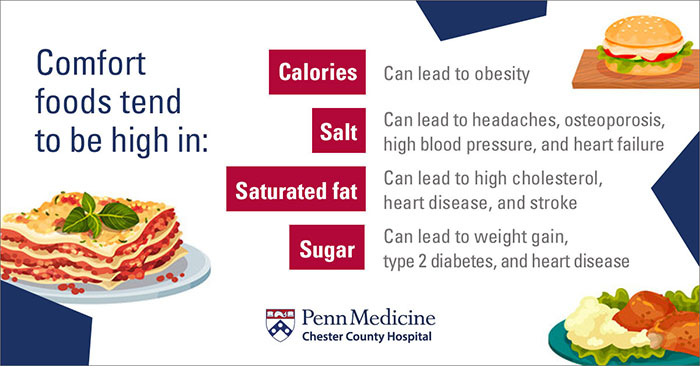For some people, it's Mom's lasagna. For others, it's a tub of ice cream. For others, it's a plate full of mashed potatoes.
Though comfort foods vary widely, the idea behind them is the same — they bring comfort to the person eating them. This might be because the food reminds them of home or of a person that brings them happiness. Or, it might be because they simply love this food, and the idea of eating it is soothing and enjoyable.
March is National Nutrition Month — a time for everyone to reassess their eating habits and find ways to develop healthier ones. And while there’s nothing wrong with finding pleasure from food, many comfort foods tend to be high in calories, and turning to unhealthy comfort foods isn’t a good habit to get into.

This National Nutrition Month, find ways to ditch the unhealthy comfort foods — and replace them with healthy (but still delicious) ones, instead. Here are 5 ways to get started.
1. Swap Refined Grains for Whole Grains (or vegetable "grains")
From mashed potatoes to fries to pasta, many comfort foods are centered around grains. However, these are often refined grains, which have less nutritional value than whole grains.
Refined grains include foods like white flour, white bread, and white rice. Unfortunately, the process of refining a grain takes away roughly a quarter of its protein and up to two-thirds of its nutrients.
Swap out some of your refined grains for whole grains, such as whole-wheat flour, oatmeal, and brown rice. If you’re really feeling ambitious, opt for vegetable “grains,” like cauliflower mashed potatoes, zucchini noodles, or carrot fries.
2. Add More Fruits and Vegetables
A simple way to improve your nutrition is simply to throw in more fruits and veggies. Comfort meal or not, these two food groups should make up at least half of your plate.
However, comfort foods tend to stray away from them, making them less nutritious.
The solution: Add broccoli to your pasta. Mix fruit into your ice cream. Throw mushrooms and green peppers onto your pizza. These are not magical fixes, and they won’t take away from the high levels of other things, like sodium, sugar, or calories. Still, fruits and veggies can add a little nutritional boost to an otherwise unhealthy meal.
3. Make Healthier Meat Choices
Fried chicken and cheeseburgers might be your go-to comfort meals, but they aren’t usually healthy. For instance, both fried foods and beef tend to be high in saturated (bad) fat.
Instead, choose lean meats like skinless poultry (chicken or turkey) or fish, which provide you with lean protein, zinc, iron, and B vitamins — but less fat. A ground turkey patty contains just 3% of an average daily value of fat, but a beef burger can take up nearly 20% of that daily value.
Additionally, rather than frying meat, opt for healthy preparation methods, like baking, broiling, roasting, stir-frying, or air-frying. For instance, you can air-fry your chicken or grill up a turkey burger for plenty of taste without the added fat.
4. Opt for Healthy Dessert Alternatives
If dessert is what comforts you, you’re not alone. Whether it’s ice cream, cookies, or chocolate bars, plenty of people turn to sweets after a rough day.
However, you can avoid overloading on sugar by finding healthy alternatives. Some ideas include:
- Low-sugar popsicles
- Frozen whipped cream
- Frozen fruit, like blueberries or grapes
- Chocolate-dipped frozen bananas
- Baked fruits, like apples or pears
By tricking your mind into thinking you’re indulging in sweets, you can find a similar amount of comfort without consuming excessive amounts of sugar.
5. Slow Down at Mealtime
On occasion, it’s okay to indulge in comfort food. However, when you’re upset, it’s easy to sit in front of your television and space out with an endless bag of potato chips or a giant bowl of ice cream. However, by not paying attention to what you’re eating, you may actually eat way more than you ever intended.
If you do decide to eat your favorite comfort food, take the time to enjoy it. Savor the flavors, and don’t rush through your meal. That way, you can enjoy a reasonable amount and not overdo it.
Finding Comfort Outside of Food
Whether you’ve had a rough day, been faced with bad news, or just need a way to unwind, everyone needs to be comforted now and then. While the occasional splurge is okay, it's also important to find comfort and stress-relief in other things, such as exercise, art, journaling, or talking to supportive loved ones.
By finding ways to make your go-to comfort food a little nutritious — and de-stressing in other ways — you can make sure your body is healthy and ready to support you for many years to come.
Learn More About Eating Healthy!
Do you have questions about incorporating healthier meals into your diet? Call 610-738-2835 or CLICK HERE to learn about One-on-One Nutrition Counseling at Chester County Hospital. Or explore our upcoming Nutrition and Weight Control programs and classes.
Related Nutrition Information from Chester County Hospital: